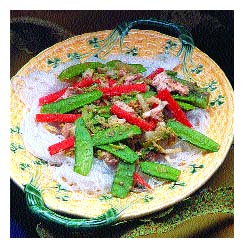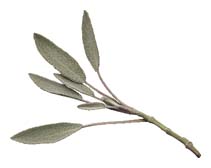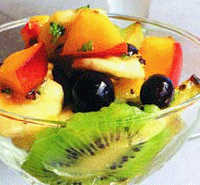
 |
|||||
|
|
|
|
|
|
|
Arouse Your Senses With Exotic-Tasting Herbsby Kris Wetherbee |
|
 For cuisine with character, there's nothing quite like the flavor of herbs to bring distinctive appeal to foods.
From the Mediterranean flair of oregano to the piney aroma of rosemary, their versatility is unsurpassed. Herbs
have been sought throughout history and traded the world over to become an essential ingredient for cooks and
connoisseurs everywhere.
For cuisine with character, there's nothing quite like the flavor of herbs to bring distinctive appeal to foods.
From the Mediterranean flair of oregano to the piney aroma of rosemary, their versatility is unsurpassed. Herbs
have been sought throughout history and traded the world over to become an essential ingredient for cooks and
connoisseurs everywhere.
Today you can embrace a new group of herbs that go beyond the ordinary, bringing with them a taste of the exotic.
Now you can experience the tropical flavor of pineapple sage or kaffir lime leaves. Take a culinary journey with
the South American native lemon verbena. Taste your way to the Orient with lemon grass, or savor the alluring
citrus/musk flavor of orange balsam thyme.
Kaffir Lime Leaves
The citrus fruit displays a green, bumpy skin and is about the size of a typical lime. Though the juice is
bitter, the strongly flavored peel is sought after in many Southeast Asian dishes, especially curry. Even
more aromatic and intensely flavored are the fresh leaves, which are sometimes available in Asian markets,
as well. Whenever citrus leaves are used in Thai cuisine, kaffir lime leaves are an irreplaceable favorite.
Use them to flavor broth, soups and stews as you would bay leaves, removing them before serving. For dishes
where they will be eaten, such as salads, stir-fries and curries, thinly slice leaves of similar size with a
sharp knife.
Lemon Grass

When available, use fresh leaves instead of dried (found with other specialty herbs and produce at most large
supermarkets as well as Asian markets), as the essential oils may be weakened or lost during the drying process.
You can use the tough outer leaves to lend a citrusy flavor to broths, soups and stews (remove them before serving).
The true treasure lies hidden beneath its outer leaves, much like a prized artichoke heart. Add minced tender
leaves and the white bulb to stuffings, sprinkle them into salads, or sizzle up a stir-fry. |
If you're feeling a bit adventurous, you can buy a plant at your local nursery or farmers' market. A
tender perennial, lemon grass is incredibly easy to grow. If you live in an area where winters are cold,
just dig it up, put it in a pot and bring it inside for the winter.
Lemon Verbena
Perhaps no other herb can appease the true lemon lover as can lemon verbena. As a proclaimed lemon lover,
I compared the flavor of six different lemon-scented herbs (lemon verbena, lemon grass, lemon balm, lemon thyme,
lemon catnip, and lemon-scented geranium). I must say, lemon verbena has become my personal favorite as well.
Often called the "queen of lemons," its leaves are brewed into a delicious pot of lemon-flavored tea. Use
leaves dried or fresh wherever a light touch of lemon flavor is welcomed. Lemon verbena lends itself well to
many foods, including drinks, salads and fruit dishes, salad dressings, marinades and baked goods as well
as desserts. Lemon verbena equally brightens the flavor of fish and chicken as well as vegetable and rice dishes.  Pineapple sage (Salvia elegans) is a master imitator when it comes to true pineapple fragrance. One whiff of its intoxicatingly delicious pineapple-scented foliage evokes visions of a refreshing tropical paradise. Indigenous to the Mediterranean, Asia Minor, Central and South America, pineapple sage has been grown in gardens for over 125 years.
Nothing quite quenches a summer thirst like a exhilarating glass of pineapple sage ice tea. Brew a sun tea with
an equal amount of lemon verbena leaves for a one-of-a-kind summertime beverage. The brilliant red
tubular flowers create a delightful edible garnish for cakes, puddings, or even ice cream.
Use fresh or dried leaves with foods that are enhanced by the light tropical flavor of pineapple. Dice a few leaves
into fruit salad, or heighten the flavor of cheeses and desserts. Add a tropical twist to jams and jellies or
vinegars and marinades. Look for pineapple sage at specialty stores or supermarkets, however, this tender perennial
is very easy to grow and widely available at garden centers. Besides, a plant this stunning should be included in
any garden or landscape.
Orange Balsam Thyme
The sensational flavor of orange balsam thyme is highly favored in West Indian cooking as well as in soups,
salads, breads, and rice dishes. As a flavored vinaigrette, this herb is outstanding. It excels in French cuisine
as well as Creole and Cajun, and can be used to season or garnish any foods that marry well with common thyme.
Most likely, you'll discover this up-and-coming herb at only the most select farmers' markets or specialty stores.
If you're unable to find orange balsam thyme in your area, this evergreen perennial can be grown throughout
most of the country. Look for plants at your local garden center or farmers' market. Two great mail order
sources are Goodwin Creek Gardens, 541/846-7357, and
Richters Herbs, 905-640-6677.
|
| Exotic Herb Recipes | |
Lemon Verbena Scones
Preheat oven to 425º F. In a large bowl, combine flour, oats, baking powder, baking soda, salt, and brown sugar.
Cut in butter until mixture resembles coarse crumbs. Add pecans and lemon verbena leaves; mix until combined.
Make a well in the center of flour mixture. Add egg, yogurt, and milk; stirring well. Mix the center in with flour
mixture to form a soft dough. Coat a 12-inch cast iron skillet with a non-stick cooking spray. With floured hands,
pat dough into skillet. Score the top into 8 pie shaped wedges.
Bake at 425º F for 15 minutes, or until lightly browned. Serve warm and enjoy. Makes 8 servings.
Pineapple Sage Tropical Fruit Compote
Combine pineapple sage leaves, wine, honey and lime juice is a small saucepan. Bring to a simmer just to
dissolve honey. Remove from heat and allow to cool to room temperature, then refrigerate until cold.
Meanwhile, prepare fruit and combine in a large glass compote or bowl. Pour syrup over fruit and gently toss to
coat. Garnish with slivered almonds and serve immediately. Makes 6 to 8 servings. |
Lemon Grass Sesame Chicken with Snow Peas
In a blender or food processor, combine lemon grass, ginger root, coconut milk, and soy sauce; blend until smooth,
then set aside. Toss sliced chicken with sesame seeds in a medium bowl; set aside.
In a large skillet or wok, heat 1/2 T. oil to medium-high. Cook sesame-coated chicken and garlic until chicken
is no longer pink; about 5 minutes. Remove chicken from skillet; set aside. Heat remaining 1 1/2 T. oil in skillet to medium-high. Add carrots and green onions; stir fry for 3 minutes. Stir in Chinese cabbage; cook for 2 to 3 minutes more. Add snow peas and stir fry about 1 to 2 minutes. Stir in lemon grass sauce and cook until heated through; about 1 to 2 minutes more. Serve on a bed of cooked bean threads or steamed white rice. Makes 4 servings.  |
|
|
||||
|
Copyright © 2008 Epicurean.com & Fezziwig Publishing Co. All rights reserved |